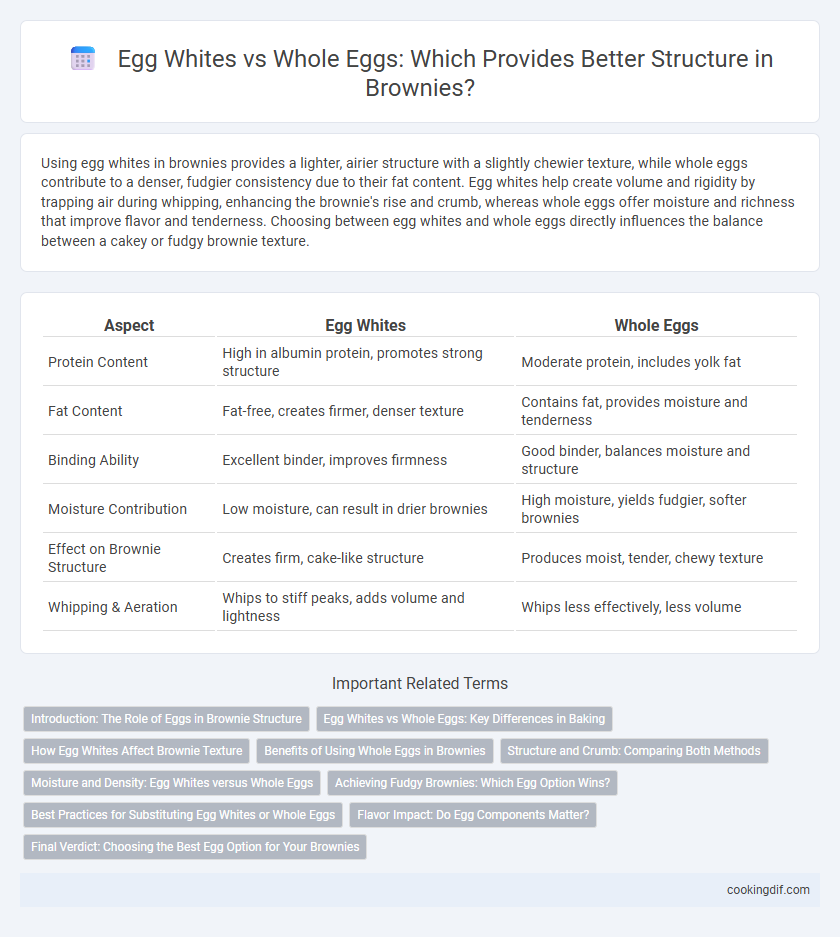Using egg whites in brownies provides a lighter, airier structure with a slightly chewier texture, while whole eggs contribute to a denser, fudgier consistency due to their fat content. Egg whites help create volume and rigidity by trapping air during whipping, enhancing the brownie's rise and crumb, whereas whole eggs offer moisture and richness that improve flavor and tenderness. Choosing between egg whites and whole eggs directly influences the balance between a cakey or fudgy brownie texture.
Table of Comparison
| Aspect | Egg Whites | Whole Eggs |
|---|---|---|
| Protein Content | High in albumin protein, promotes strong structure | Moderate protein, includes yolk fat |
| Fat Content | Fat-free, creates firmer, denser texture | Contains fat, provides moisture and tenderness |
| Binding Ability | Excellent binder, improves firmness | Good binder, balances moisture and structure |
| Moisture Contribution | Low moisture, can result in drier brownies | High moisture, yields fudgier, softer brownies |
| Effect on Brownie Structure | Creates firm, cake-like structure | Produces moist, tender, chewy texture |
| Whipping & Aeration | Whips to stiff peaks, adds volume and lightness | Whips less effectively, less volume |
Introduction: The Role of Eggs in Brownie Structure
Eggs play a crucial role in defining the structure and texture of brownies by providing stability and moisture. Whole eggs contribute fat and richness, resulting in a fudgy, dense consistency, while egg whites primarily deliver protein that strengthens the crumb and creates a lighter, more cake-like texture. Understanding the distinction between egg whites and whole eggs allows bakers to tailor brownie recipes to achieve the desired balance of softness and firmness.
Egg Whites vs Whole Eggs: Key Differences in Baking
Egg whites provide a lighter, airier texture due to their high protein content, which helps create structure and volume in brownies. Whole eggs contribute both fat and moisture from the yolk, resulting in richer, denser, and more tender brownies. Using whole eggs typically enhances flavor and adds binding properties, while egg whites focus on firmness and leavening.
How Egg Whites Affect Brownie Texture
Egg whites contribute to a lighter, airier brownie texture by providing more structure through protein coagulation and trapping air during baking. Using only egg whites results in a firmer, less dense crumb with increased chewiness, as opposed to the richness and moisture added by whole eggs containing yolks. The absence of yolks reduces fat content, causing brownies to have a drier, more cake-like consistency rather than a fudgy one.
Benefits of Using Whole Eggs in Brownies
Using whole eggs in brownies enhances moisture and richness, contributing to a tender yet firm texture. The yolks add fat that improves flavor depth and helps create a fudgier crumb compared to egg whites alone. Whole eggs also provide emulsifying properties, ensuring even mixing of ingredients and consistent structure throughout the brownie.
Structure and Crumb: Comparing Both Methods
Using egg whites in brownies creates a lighter, airier structure with a more delicate crumb due to the protein's ability to trap air during whipping. Whole eggs contribute to a denser, fudgier texture by providing fat and emulsifiers that enhance moisture retention and richness. The choice between egg whites and whole eggs directly impacts the brownie's overall structure and crumb, with egg whites yielding a cakier result and whole eggs resulting in a more traditional, chewy brownie texture.
Moisture and Density: Egg Whites versus Whole Eggs
Egg whites contribute to a lighter, airier brownie texture by providing structure without adding fat, resulting in lower density and higher moisture evaporation during baking. Whole eggs add richness and fat, increasing moisture retention and producing a denser, fudgier crumb with a more pronounced mouthfeel. Choosing egg whites creates a cakier, less dense brownie, while whole eggs yield a moister, denser treat with enhanced flavor depth.
Achieving Fudgy Brownies: Which Egg Option Wins?
Using whole eggs in brownies provides optimal structure and moisture, resulting in a fudgy, dense texture favored by most bakers. Egg whites alone contribute more protein and stability but tend to create a cakier, less rich brownie due to reduced fat content. For achieving the perfect fudgy consistency, whole eggs remain the preferred choice as their yolks add essential fat that enhances both texture and flavor.
Best Practices for Substituting Egg Whites or Whole Eggs
Using whole eggs in brownies enhances moisture and richness due to the yolks' fat content, providing a denser and fudgier texture. Egg whites primarily contribute to structure and leavening by adding protein, resulting in a lighter, more cakey brownie. When substituting, combine egg whites with a small amount of fat or moisture, such as oil or yogurt, to mimic the yolk's richness while maintaining proper structure.
Flavor Impact: Do Egg Components Matter?
Egg whites contribute primarily to the structure of brownies by providing protein that helps create a light, airy texture, while whole eggs add richness and enhance flavor through the yolk's fat content. The yolk contains emulsifiers and fats that deepen the chocolate taste and contribute to a moist, tender crumb. Choosing between egg whites and whole eggs directly impacts the brownie's texture and depth of flavor, making the egg components crucial for balancing structural integrity and taste.
Final Verdict: Choosing the Best Egg Option for Your Brownies
Whole eggs provide optimal structure and moisture for brownies, balancing richness and density while ensuring a tender crumb. Egg whites contribute to a lighter, more cakey texture but may result in a drier final product lacking richness. For fudgy and moist brownies with a well-rounded texture, whole eggs remain the superior choice.
Egg Whites vs Whole Eggs for structure Infographic

 cookingdif.com
cookingdif.com